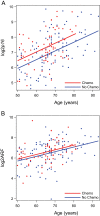Effect of cytotoxic chemotherapy on markers of molecular age in patients with breast cancer
- PMID: 24681605
- PMCID: PMC3982894
- DOI: 10.1093/jnci/dju057
Effect of cytotoxic chemotherapy on markers of molecular age in patients with breast cancer
Abstract
Background: Senescent cells, which express p16 (INK4a) , accumulate with aging and contribute to age-related pathology. To understand whether cytotoxic agents promote molecular aging, we measured expression of p16 (INK4a) and other senescence markers in breast cancer patients treated with adjuvant chemotherapy.
Methods: Blood and clinical information were prospectively obtained from 33 women with stage I to III breast cancer at four time points: before anthracycline-based chemotherapy, immediately after anthracycline-based chemotherapy, 3 months after anthracycline-based chemotherapy, and 12 months after anthracycline-based chemotherapy. Expression of senescence markers p16 (INK4a) and ARF mRNA was determined using TaqMan quantitative reverse-transcription polymerase chain reaction in CD3(+) T lymphocytes, telomere length was determined by Southern analysis, and senescence-associated cytokines were determined by enzyme-linked immunosorbent assay. Findings were independently assessed in a cross-sectional cohort of 176 breast cancer survivors enrolled a median of 3.4 years after treatment; 39% previously received chemotherapy. All statistical tests were two-sided.
Results: In prospectively analyzed patients, expression of p16 (INK4a) and ARF increased immediately after chemotherapy and remained elevated 12 months after treatment. Median increase in log2 p16 (INK4a) was 0.81 (interquartile range = 0.28-1.62; Wilcoxon signed-rank P < .001), or a 75% absolute increase in expression, equivalent to the increase observed over 14.7 years of chronological aging. ARF expression was comparably increased (P < .001). Increased expression of p16 (INK4a) and ARF was associated with dose-dense therapy and hematological toxicity. Expression of two senescence-associated cytokines (VEGFA and MCP1) was durably increased by adjuvant chemotherapy. Telomere length was not affected by chemotherapy. In a cross-sectional cohort, prior chemotherapy exposure was independently associated with a log2-increase in p16 (INK4a) expression of 0.57 (repeated measures model, P < .001), comparable with 10.4 years of chronological aging.
Conclusions: Adjuvant chemotherapy for breast cancer is gerontogenic, inducing cellular senescence in vivo, thereby accelerating molecular aging of hematopoietic tissues.
Figures



Comment in
-
Chemotherapy: life gained, years lost?Nat Rev Clin Oncol. 2014 Jun;11(6):303. doi: 10.1038/nrclinonc.2014.67. Epub 2014 Apr 22. Nat Rev Clin Oncol. 2014. PMID: 24751802 No abstract available.
Similar articles
-
Chemotherapy: life gained, years lost?Nat Rev Clin Oncol. 2014 Jun;11(6):303. doi: 10.1038/nrclinonc.2014.67. Epub 2014 Apr 22. Nat Rev Clin Oncol. 2014. PMID: 24751802 No abstract available.
-
Role of senescence marker p16 INK4a measured in peripheral blood T-lymphocytes in predicting length of hospital stay after coronary artery bypass surgery in older adults.Exp Gerontol. 2016 Feb;74:29-36. doi: 10.1016/j.exger.2015.12.003. Epub 2015 Dec 9. Exp Gerontol. 2016. PMID: 26692418 Free PMC article.
-
Chemotherapy and Stem Cell Transplantation Increase p16INK4a Expression, a Biomarker of T-cell Aging.EBioMedicine. 2016 Sep;11:227-238. doi: 10.1016/j.ebiom.2016.08.029. Epub 2016 Aug 21. EBioMedicine. 2016. PMID: 27591832 Free PMC article.
-
Continued value of adjuvant anthracyclines as treatment for early breast cancer.Lancet Oncol. 2015 Jul;16(7):e362-9. doi: 10.1016/S1470-2045(15)00079-0. Lancet Oncol. 2015. PMID: 26149888 Review.
-
The molecular balancing act of p16(INK4a) in cancer and aging.Mol Cancer Res. 2014 Feb;12(2):167-83. doi: 10.1158/1541-7786.MCR-13-0350. Epub 2013 Oct 17. Mol Cancer Res. 2014. PMID: 24136988 Free PMC article. Review.
Cited by
-
Barriers to the Preclinical Development of Therapeutics that Target Aging Mechanisms.J Gerontol A Biol Sci Med Sci. 2016 Nov;71(11):1388-1394. doi: 10.1093/gerona/glw112. Epub 2016 Aug 16. J Gerontol A Biol Sci Med Sci. 2016. PMID: 27535964 Free PMC article.
-
Does walking during chemotherapy impact p16INK4a levels in women with early breast cancer.J Clin Lab Anal. 2022 Dec;36(12):e24753. doi: 10.1002/jcla.24753. Epub 2022 Nov 6. J Clin Lab Anal. 2022. PMID: 36336905 Free PMC article.
-
Frailty and pre-frailty associated with long-term diminished physical performance and quality of life in breast cancer and hematopoietic cell transplant survivors.Aging (Albany NY). 2024 Sep 26;16(18):12432-12442. doi: 10.18632/aging.206109. Epub 2024 Sep 26. Aging (Albany NY). 2024. PMID: 39330993 Free PMC article.
-
Cancer-Related Cognitive Outcomes Among Older Breast Cancer Survivors in the Thinking and Living With Cancer Study.J Clin Oncol. 2018 Oct 3;36(32):JCO1800140. doi: 10.1200/JCO.18.00140. Online ahead of print. J Clin Oncol. 2018. PMID: 30281396 Free PMC article.
-
Cognitive Effects of Cancer and Cancer Treatments.Annu Rev Clin Psychol. 2018 May 7;14:425-451. doi: 10.1146/annurev-clinpsy-050817-084903. Epub 2018 Jan 18. Annu Rev Clin Psychol. 2018. PMID: 29345974 Free PMC article. Review.
References
-
- Smith BD, Smith GL, Hurria A, et al. Future of cancer incidence in the United States: burdens upon an aging, changing nation. J Clin Oncol. 2009;27(17):2758–2765 - PubMed
-
- Siegel R, DeSantis C, Virgo K, et al. Cancer treatment and survivorship statistics, 2012. CA Cancer J Clin. 2012;62(4):220–241 - PubMed
Publication types
MeSH terms
Substances
Grants and funding
LinkOut - more resources
Full Text Sources
Other Literature Sources
Medical

